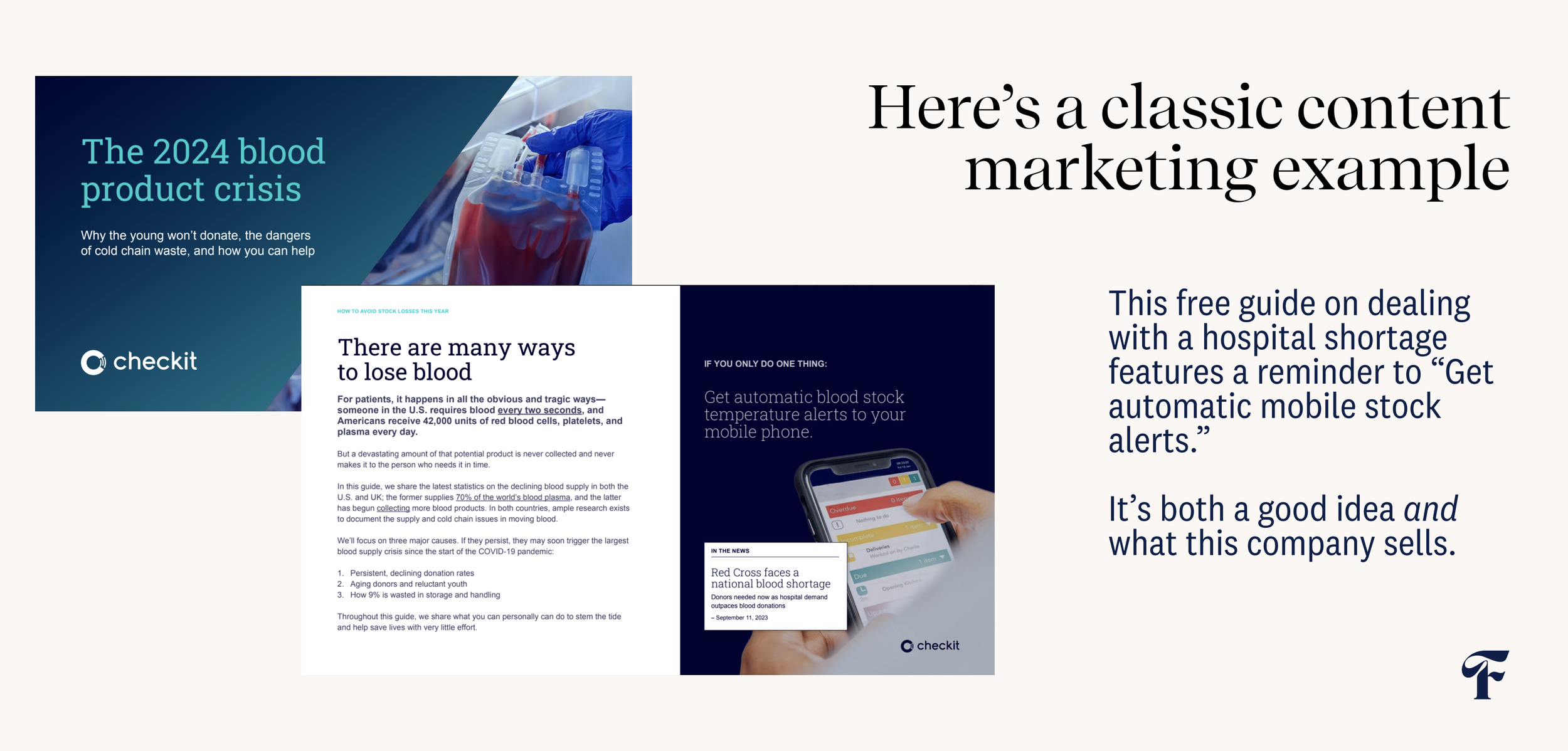
Content marketing is when companies produce useful, free information—articles, podcasts, videos, books, newsletters, and more—to aid, inform, and entertain their customers. It’s not a pitch. It’s catch-free help. And it often blurs the lines between entertainment and marketing to help the company producing it reach a much wider audience than it could with pushy, product-filled offers. In this guide, we’ll talk about how you can use it to increase your revenue. And also why true content marketing has become vanishingly rare.
Why do companies use content marketing?
The classic example of content marketing is this: You sell budgeting software, so you write a guide about how to buy budgeting software which does not explicitly mention your own. By offering this information free, you get to craft the frame of reference through which your buyer sees budgeting software. You set their expectations around what’s possible and desirable. The hope is that if your guide is genuinely useful, they’ll remember and trust you, and when they’re ready to sign up, you’re their first thought.
If that sounds like a lot more work than running an ad, it sorta is. But there’s a very good reason it exists.

Companies use content marketing because the power equation has flipped—consumers and business buyers used to have to trust salespeople and ads to learn about new products. Now, with the internet, information is free and abundant. They can look things up. They can ask strangers. They’ve almost all the information they need. Buyers have all the power, and anyway, they’re deathly sick of propagandist advertising where they’re told they are not enough and the only cure is to buy more.
“Companies use content marketing because the power equation has flipped—buyers now have the power.”
For all these reasons, buyers no longer behave like they used to. One-quarter of all internet users block ads. Half of people ignore emails. They tune out most messages and rightfully suspect that companies that reach out to them are trying to sell.
They instead place their trust in other people on social media, review sites, forums, industry bodies, management consultancies, and niche sites.
Content marketing is one way to still reach these individuals. “We need to stop interrupting what people are interested in and be what they are interested in,” opined Craig Davis, Chief Creative Officer of the advertising agency J. Walter Thompson. Rather than beg for attention, content marketing helps you become the trusted source of information.
Content marketing isn’t new
Ever heard of the Michelin star rating system for restaurants? That started in 1920 as a restaurant guidebook to encourage drivers to drive more (and help the tire company behind it sell more tires). Or what about soap operas? Those began as soap company-sponsored radio dramas to, you guessed it, sell more soap.
What is new these days though is the ease and velocity with which businesses like yours can produce so-called content—articles, videos, newsletters, guides, microsites, and the like. Generative AI and freelancing sites mean any sized business can write, design, and publish loads of free information.
But let us tell you, that’s a blessing and a curse. Now that everyone can, everyone is, and the internet is bursting with mediocrity: repetitive content that copies what everyone else has already written and looks identical. It doesn’t stand out and it doesn’t teach, so it can’t achieve its goals.
Your content must actually share something valuable. Otherwise, it’s a waste of both the reader’s time and yours.
Which brings us to the reason we wrote this guide: Many companies are “doing content marketing.” But very few are doing it right, and even fewer, well.
Let’s examine that difference.
Benefits of content marketing MAY INCLUDE:
- A stronger reputation—Become known as an authority.
- Magnify your reach—Get shared far beyond your present market.
- Increase sales—Educate buyers so they’re better at buying.
- Improve retention—Teach customers to use the product even better.
- Improve SEO—If your ideas are useful, Google will serve them up.
- Build a culture of insight—Clear writing is clear thinking and by organizing information for others, you’ll get even clearer for yourself.
Speaking of getting clear, want to market smarter?

Why Some Companies ROUTINELY FAIL AT Content Marketing
It’s much easier to get content marketing wrong than it is to get it right. Good content is created for the primary purpose of being useful to the reader. It is selfless. It’s more give than get. Yet if you work for a company that’s trying to sell more products, it’s very difficult to think that way, and companies end up droning on about themselves like a bore at a cocktail party.

The problem is that marketers within a company believe that if they find a topic interesting, others will too. This is known as projection bias and it leads them to grossly overestimate their audience’s interest in their articles and podcasts. It also turns those articles and podcasts into shameless pitches. Selfish content like this turns readers off, and they ignore it just as they do ads.
“What a lot of companies get wrong is they focus too heavily on their own products and on their own sales strategy.”
— BILL CONNOLLY, MONOTYPE
For an example of bad content marketing, go back and read any story about GE’s stand-alone blog Ecomagination, which is no longer active, but you can find in the wayback machine. The Ecomagination initiative began as an inspiring opportunity to talk about the intersection of technology and climate—but after countless myopically focused internal GE reviewers had their say, it morphed into a mouthpiece for its products. The resulting publication confused readers. “Is it a marketing campaign? A corporate strategy? A guide for product and service development?” wondered the Harvard Business Review. Ecomagination tried to be too much—and too much about GE—and so felt like it was shilling light bulbs rather than illuminating the world.
And in the end they of course wasted lots of money and then shuttered it.
So that’s the first big thing to get right: Be more for your readers than you are for you. Because if they like you, and you have an audience and platform, you win as well.
Only then can you begin to worry about other aspects, like how well it’s written, how carefully the stories are chosen, and whether readers actually view it as helpful.
Content fails when it’s:
- Narcissistic: Mostly about the company with very little value—and certainly no objective credibility—to the reader.
- Poorly written: The writing is full of jargon, buzzwords, and cliché which makes the text impenetrable to the lay reader.
- Wordy: Nobody pared the content down to just the parts that interest readers.
- Boring: The content fails to capture the humanity of its subjects and gets mired in discussing product features.
- Unhelpful: The pieces don’t offer clear educational or entertainment value.
To escape the projection bias trap, and to know if they’re genuinely being of service to readers, there’s really no way around going straight to the source and studying your readers. A shockingly low one-third of marketers talk to their customers. An unsurprising vast majority of those marketers outperform the rest—especially at content marketing.
Examples Of Good, GENUINELY USEFUL Content Marketing
1. Voiceflow’s publication exists to serve readers
Voiceflow had tens of thousands of designer users who wanted a place to gather and share. Voiceflow’s existing blog wasn’t providing that—many of the posts were simply about the company’s products. So Voiceflow’s marketing team hired the Fenwick team to reimagine it as a publication. We helped name it, designed the whole system, wrote the copy (with fun touches like the author bios), and continue to produce the articles and art. Their traffic quintupled, they gained a lot of new users, and their top contributor is being invited to speak at conferences.

2. Mixpanel’s blog takes a social stand
Mixpanel gave its blog a name – The Signal – and uses it to help product teams understand their data and build more diverse, inclusive, and successful companies. The Signal’s team publishes articles on everything from how diversity helped Uber to how to understand statistical significance. It rarely, if ever, mentions Mixpanel, or that the company sells analytics software.
2. Dollar Shave Club transfors a commodity into entertainment
Dollar Shave Club is famous for rocketing to a billion-dollar valuation based almost entirely on a single irreverent YouTube video where founder Michael Dubin drops lines like “Are our blades any good? No. They’re f**cking great.” The team parlayed that clip into a mini-media empire. Consumers have come to expect Dollar Shave Club to entertain them, and the company delivers with a branded publication and mailer that arrives with its shave kits.
3. Zendesk attracts leads with branded publication, Relate
Customer support software firm Zendesk has a stand-alone blog Relate that covers uncomfortable topics and tells the truth about work – like how not to be an asshole. According to Zendesk Editor Suzanne Barnecut, Relate helps them expand their audience and cover topics their readers care about, whether or not it has anything to do with the company.
“We think of [Relate] as a product-agnostic space ... a mostly sales-free zone where customers and potential buyers can consume content that is useful, relevant, and sometimes entertaining,” said Suzanne. “Relate offers a way to begin and continue a conversation and relationship with our audience.”
More brand publications:
- Pathways by Voiceflow
- Atlas by Bessemer Venture Partners
- Furthermore by Equinox
- Into by Grindr
- Breaking2 by Nike
- The Output by Peloton
- Learn from Experience by Farmers Insurance
- USAA Stories by USAA
- The Cleanest Line by Patagonia
- First Round Review by First Round
- Several People are Typing by Slack
- Here by Away
For more content marketing inspiration, check out our blog post: The Best B2B Blogs To Nourish Your Writer Brain.
Denny’s went rogue and trampled social media convention
Content marketing isn’t just writing articles (though that’s by far the most common medium). The diner chain Denny’s created a spectacle on social media by slinging mud and reveling in the public outcry over its lack of shame.
On social media, Denny’s isn’t selling pancakes: It’s earning mindshare by being vulgar and entertaining. And even when it does pitch pancakes, it’s more concerned with being funny than appetizing.
Podcasts
Over 67 million people ages 12 and older listen to podcasts which are increasingly considered a serious and respected medium for communicating your message. Their genius is that audio content doesn’t compete for screen time: It exists in an untrammeled “third-space” where people otherwise can’t read, such as during commutes, workouts, or chores.
Branded podcasts:
- Rise and Grind sponsored by ZipRecruiter
- In Your Dreams by Casper
- Fortune Favors the Bold by MasterCard
- future by Microsoft
- The Message by GE
TV shows and movies
Though not as common, some consumer brands produce feature-length films. The Lego Movie, for example, snowballed into a blockbuster franchise with three films, four cross-promotional spin-offs (Lego Star Wars, anyone?), and two video games. Every scene and character in Lego’s films and games are made of products it actually sells. They are effectively giant ads, but ones that are so entertaining people pay to watch.
Book and print magazines
The founders of the content marketing software firm Contently went from high-tech to old-school by writing a paperback book about storytelling. So did the founder of the analytics firm TrackMaven. And before all of them, Ann Handley, founder of the marketing education site MarketingProfs, wrote Everybody Writes, which hit The New York Times Best Seller list and, seven years after its publication, still drives crowds of aspiring marketers and writers to the company’s site.
Contently, TrackMaven, and MarketingProfs didn’t give away their books – they sold them. Millions of readers paid tens of millions of dollars because all three companies nailed the point of content marketing: Create content that’s so useful that readers would pay for it.
“For your marketing to be so useful that people want it and would gladly pay for it, you have to understand what your customers need to make better decisions, and how you can improve their lives by providing it.”
— JAY BAER, CONVINCE AND CONVERT
Some brands, perhaps suspecting their audience of having shorter attention spans, print magazines. The mattress retailer Casper, for example, publishes and sells Woolly, a magazine that’s “a curious exploration of comfort and wellness in modern life” that rarely mentions bedding.
Examples Of Bad Content Marketing
Nestlé tried to make National Bunny Ears Day happen
In the fall of 2013, Nestle launched a multichannel marketing campaign that implored consumers to tag a photo with themselves wearing bunny ears with the hashtag #NationalBunnyEarsDay. Only, nobody had heard of such a holiday, it wasn’t very funny, and consumers saw it as a tone-deaf product pitch. Nobody cared and few participated.
GE’s Ecomagination was unimaginative and boring
GE launched a branded blog to talk about green initiatives. Only, the parent company retained too much editorial control and their marketing mindset of ‘always be selling’ died hard – but only after a decade of trying to grow the blog. In the words of one commentator, “It looks more like a news section of a site than a thought-leadership blog. This distances them from their audience and hurts their brand. People want to hear about the issues, not that your company is greener than an Irish bar on St. Patrick’s Day.”
How To Get Started With Content Marketing
Content marketing has one major downside: It’s time-consuming and it can take a long time to pay off. “Content marketing takes a lot of work, persistence, and patience – it’s not for everyone,” says Michelle Linn, Chief Strategy Officer at Mantis Research.
Some companies invest years before seeing the results. For example, Copyblogger, a marketing agency with a blog of the same name, invested heavily in articles in 2012 that didn’t immediately prove useful. But now, six years later, many of those articles show up as top Google search results and the company is reaping the benefits. Here’s how to give your content the best chance of success:
1. Experiment
Every business has a unique audience, brand, and point of view, and every marketer has to find what works for them. The best tool for that is a bit of mental technology that toddlers excel at: trial and error. Start creating content on many channels and see what sticks. Write contributed articles to industry publications and read the comments. Ask questions on LinkedIn to see which questions people reply to. When something consistently fails to work, stop doing it.
This is the route CB Insights, a private data firm, has followed since 2013, and it’s grown its blog from a few hundred followers to 500,000. “When you find a theme that works, flood the zone and do more of it,” says Anand Sanwal, CEO of CB Insights. “People responded favorably when CB Insights shared bad data visualizations or nonsensical pie charts or when we made fun of management consultant frameworks that were gibberish. So we did more of those. Once you find things that work, do more of them.”
“Once you find things that work, do more of them.”
— ANAND SANWAL, CB INSIGHTS
Here are popular content formats:
- Launch a blog
- Publish a newsletter
- Contribute articles to industry publications
- Build a social media following
- Create a video series
- Launch an email nurture
- Develop online training courses
- Produce a TV miniseries or movie
- Launch a podcast
- Write a book
2. Document your strategy
When your experiments bear fruit, create a content marketing playbook that codifies what works and what doesn’t. That playbook should include four chapters:
1. Customer research: Who’s your audience? Summarize them into personas so your team has a customer in mind when they write content.
2. Content strategy: What should you publish where? Daily or weekly? What color schema? What tone?
3. Analytics and optimization: How will you track and measure the success of each piece of content? Whose job is it to amend the playbook when you learn something new?
4. Growth plan: How will your strategy change as you grow? If you had a larger audience or more resources, where would you invest it?
3. Test and repeat
Content marketing is a marathon and all winners travel light. As you test, it’s just as important to discover what doesn’t work and to stop doing it as it is to find what works. The mattress company Casper was brave enough to shutter its first branded publication, Rip Van Winkle, when, after several years, it was clear that it wasn’t paying off. GE accepted defeat with its Ecomagination blog, and McDonald’s abandoned its podcast The Sauce, a spoof on NPR’s podcast Serial, after only three episodes.
Closing doors frees you to reallocate your time to the channels and formats that actually interest readers. That way, you have a chance of discovering formats so valuable readers would pay for them. And we can’t say the same for your ads.
